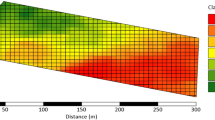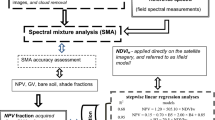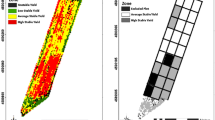Abstract
Site-specific in-season corn (Zea mays L.) nitrogen (N) rate recommendations based on remote sensing can increase nitrogen use efficiency (NUE) but most approaches require the corn to be at the V8 growth stage. Success in estimating N needs during early vegetative growth has been limited due to low plant biomass and background interference. The objective of this experiment was to measure the influence of soil series, soil moisture, surface crop residues, and sensor orientation on Normalized Difference Vegetation Index (NDVI) from soils prior to planting and corn from planting through the V6 growth stage. A controlled experiment was conducted in Virginia using four soil types commonly used for corn production. Spectral reflectance readings from the soils and four crop residues were measured using the GreenSeeker® sensor at four sensor orientations. Sensor orientation affected NDVI readings from bare soils before planting, with a difference of up to 0.16 units among orientations. The 15 cm mask generally resulted in the lowest NDVI. Wetting soils resulted in greater NDVI values from all soils with differences of up to 0.18 units between the same soil wet and dry. Values for NDVI were initially influenced by crop residue type but no differences due to type were detected once corn reached the V4 stage. Altering sensor orientation generally changed NDVI values but none resulted in NDVI that was similar across all soil and residue backgrounds. Background (soil and residue) influenced NDVI readings during early vegetative corn growth so the sensing background for the calibration reference areas should be uniform and similar to the larger field for implementation of the GreenSeeker® variable rate system.



Similar content being viewed by others
References
Abendroth, L. J., Elmore, R. W., Boyer, M. J., & Marlay, S. K. (2011). Corn growth and development. PMR 1009. Ames, IA: Iowa State University Extension.
Campbell, J. B., & Wynne, R. H. (2011). Introduction to remote sensing (5th ed.). New York, NY: The Guilford Press.
Escadafal, R., Girard, M., & Couralt, D. (1989). Munsell soil color and soil reflectance in the visible spectral bands of Landsat MSS and TM data. Remote Sensing of Environment, 27, 37–46.
Gilabert, M. A., González-Piqueras, J., García-Haro, F. J., & Meliá, J. (2002). A generalized soil-adjusted vegetation index. Remote Sensing of Environment, 82(2–3), 303–310.
Harrell, D. L., Tubaña, B. S., Walker, T. W., & Phillips, S. B. (2011). Estimating rice grain yield potential using normalized difference vegetation index. Agronomy Journal, 103(6), 1717–1723.
Holland, K. H., Lamb, D. W., & Schepers, J. S. (2012). Radiometry of proximal active optical sensors (AOS) for agricultural sensing. Selected Topics in Applied Earth Observations and Remote Sensing, IEEE Journal of, 5, 1793–1802. doi:10.1109/jstars.2012.2198049.
Huete, A. R. (1988). A soil-adjusted vegetation index (SAVI). Remote Sensing of Environment, 25(3), 295–309.
Huete, A. R., & Escadafal, R. (1991). Assessment of biophysical soil properties through spectral decomposition techniques. Remote Sensing of Environment, 35, 149–159.
Huete, A. R., Jackson, R. D., & Post, D. F. (1985). Spectral response of a plant canopy with different soil backgrounds. Remote Sensing of Environment, 17(1), 37–53.
Hutchinson, C. F. (1982). Techniques for combining Landsat and ancillary data for digital classification improvement. Photogrammetric Engineering and Remote Sensing, 48, 123–130.
Inman, D., Khosla, R., Reich, R. M., & Westfall, D. G. (2007). Active remote sensing and grain yield in irrigated maize. Precision Agriculture, 8(4–5), 241–252.
Jones, J., Moody, J., Shear, G., Moschler, W., & Lillard, J. (1968). The no-tillage system for corn (Zea mays L.). Agronomy Journal, 60(1), 17–20.
Kang S.S., Hong H.Y., Kim Y.H., Ha S.K., Hong S.D. (2009) Factors affecting reflectance indics in ground-based active sensors. In: Proceedings 9th International Conference of the East and Southeast Asia Federation of Soil Science Societies, Seoul.
Khosla, R., & Alley, M. (1999). Soil-specific nitrogen management on mid-Atlantic coastal plain soils. Better Crops with Plant Food, 83(3), 6–7.
Kipp S., Mistele B., & Schmidhalter U. (2012) Active sensor performance – dependence on measuring height, device temperature and light intensity. In: Proceedings of the 11th international conference on precision agriculture, 15–18 July, 2012, Indianapolis, Indiana USA. Monticello, IL: The International Society of Precision Agriculture.
Liu, H. Q., & Huete, A. (1995). A feedback based modification of the NDVI to minimize canopy background and atmospheric noise. IEEE Transactions on Geoscience and Remote Sensing, 33(2), 457–465.
Ma, B. L., & Dwyer, L. M. (1998). Nitrogen uptake and use of two contrasting maize hybrids differing in leaf senescence. Plant and Soil, 199(2), 283–291.
Ma, B. L., Ying, J., Dwyer, L., Gregorich, E., & Morrison, M. (2003). Crop rotation and soil N amendment effects on maize production in eastern Canada. Canadian Journal of Soil Science, 83, 483–495.
Maguire, R., Alley, M., & Flowers, W. (2009). Fertilizer types and calculating application rates 424–035. Blacksburg, VA: Virginia Cooperative Extension.
Maguire, R. O., & Heckendorn, S. E. (2011). Soil test recommendations for Virginia. Blacksburg, VA: Virginia Cooperative Extension.
Martin, D. E., Lopez, J. D, Jr, & Lan, Y. (2012). Laboratory evaluation of the GreenSeeker handheld optical sensor to variations in orientation and height above canopy. International Journal of Agricultural and Biological Engineering, 5(1), 43–47.
Munsell, A. H. (2000). Munsell soil color charts. New Windsor: Gretag-Macbeth.
Nagler, P. L., Daughtry, C. S. T., & Goward, S. N. (2000). Plant litter and soil reflectance. Remote Sensing of Environment, 71(2), 207–215.
NTech Industries Inc. (2008). Technical Notes: How to use the crop-specific algorithms provided with the GreenSeeker RT200 System. Ukiah, CA: NTech Industries. Retrieved from 15 Apr 2015 http://trl.trimble.com/docushare/dsweb/Get/Document-635949/How_to_use_Crop_Algorithms_080606.pdf.
Institute, S. A. S. (2008). The SAS system for Windows. Cary, NC: SAS Inst.
Peñuelas, J., Gamon, J. A., Fredeen, A. L., Merino, J., & Field, C. B. (1994). Reflectance indices associated with physiological changes in nitrogen- and water-limited sunflowers. Remote Sensing of Environment, 48, 135–146.
Qi, J., Chehbouni, A., Huete, A., Kerr, Y., & Sorooshian, S. (1994). A modified soil adjusted vegetation index. Remote Sensing of Environment, 48(2), 119–126.
Raun, W. R., Solie, J. B., Johnson, G. V., Stone, M. L., Lukina, E. V., Thomason, W. E., et al. (2001). In-season prediction of potential grain yield in winter wheat using canopy reflectance. Agronomy Journal, 93(1), 131–138.
Reiter, M. S. (2009). Conservation tillage trends in Virginia agricultural production: A multidisciplinary approach to conservation. In: M.S. Reiter (ed.), Proceedings of the 31st Southern Conservation Agriculutre Systems Conference (pp. 2–11). Melfa, VA: Virginia Cooperative Extension.
Ruffo, M. L., Bollero, G. A., Bullock, D. S., & Bullock, D. G. (2006). Site-specific production functions for variable rate corn nitrogen fertilization. Precision Agriculture, 7(5), 327–342.
Solari, F. (2006). Develo** a crop based strategy for on-the-go nitrogen management in irrigated cornfields. Lincoln: University of Nebraska.
Solari, F., Shanahan, J., Ferguson, R., Schepers, J., & Gitelson, A. (2008). Active sensor reflectance measurements of corn nitrogen status and yield potential. Agronomy Journal, 100(3), 571–579.
Solie, J. B., Monroe, A. D., Raun, W. R., & Stone, M. L. (2012). Generalized algorithm for variable-rate nitrogen application in cereal grains. Agronomy Journal, 104(2), 378–387.
Sudduth, K., Kitchen, N., Drummond, S., & House, G. (2011). Nadir and oblique canopy reflectance sensing for N application in corn. In: Proceedings of the ASABE Annual International Meeting, Louisville, KY, 7–10 Aug. Paper 1111261 2011.
Thomason, W. E., Phillips, S. B., & Raymond, F. D. (2007). Defining useful limits for spectral reflectance measures in corn. Journal of Plant Nutrition, 30(8), 1263–1277.
Tubana, B. S., Arnall, D. B., Walsh, O., Chung, B., Solie, J. B., Girma, K., et al. (2008). Adjusting midseason nitrogen rate using a sensor-based optimization algorithm to increase use efficiency in corn. Journal of Plant Nutrition, 31(8), 1393–1419.
USDA-NRCS (2011). National agronomy manual. Washington, DC: USDA-NRCS. Retrieved from 15 April 2015 http://www.nrcs.usda.gov/Internet/FSE_DOCUMENTS/stelprdb1043210.pdf.
USDA-NRCS (2013). Official soil series descriptions (OSDs) with series extent map** capabilities. Washington, DC: USDA-NRCS. Retrieved from 15 April 2015https://soilseries.sc.egov.usda.gov/osdname.asp.
Author information
Authors and Affiliations
Corresponding author
Rights and permissions
About this article
Cite this article
Jones, J.R., Fleming, C.S., Pavuluri, K. et al. Influence of soil, crop residue, and sensor orientations on NDVI readings. Precision Agric 16, 690–704 (2015). https://doi.org/10.1007/s11119-015-9402-0
Published:
Issue Date:
DOI: https://doi.org/10.1007/s11119-015-9402-0




